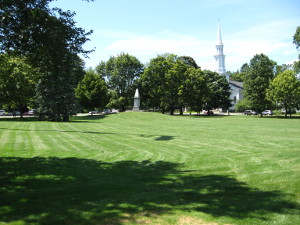From: Proceedings of Lexington Historical Society and papers relating to the history of the town
ROBERT MUNROE.
Read by G. W. Sampson, Oct. 12, 1857.
 Among old Lexington families, the Munroes stand second to none. In civil life or in time of war, they were always found at or near the front. Perhaps the three most distinguished in the Revolutionary period were Robert, Edmund, and William. I am here to speak for Robert, not because he was superior in any way to the others, but because he was my ancestor. Robert Munroe was born in Lexington, May 4, 1712.
Among old Lexington families, the Munroes stand second to none. In civil life or in time of war, they were always found at or near the front. Perhaps the three most distinguished in the Revolutionary period were Robert, Edmund, and William. I am here to speak for Robert, not because he was superior in any way to the others, but because he was my ancestor. Robert Munroe was born in Lexington, May 4, 1712.
The old stock of Munroes first settled, as I am told, in that part of Lexington which takes its name, “Scotland,” from their nationality. They can be traced as far back as the time of Bruce in Scotland. We read of them at Bannockburn, Berwick, Edinburgh, in the Protestant war in Germany, in Sweden, and even in India, fighting sturdily and steadily on every occasion. Up to 165 1 the Munroes could boast of three generals, eight colonels, five lieutenant-colonels, eleven majors, more than thirty captains, and a large number of subalterns. We find the Munroes again in command of large forces in the Irish Rebellion, at Fontenoy, at Falkirk and elsewhere; everywhere, indeed, but in the rear, when there was fighting at the front.
It is an old saying that “blood will tell.” When a military spirit becomes infused through generations, it only needs a spark of war to ignite the latent energy in a man and develop a first-class soldier. It follows with almost as much certainty as if he were a chemical compound, the occasion for the display of warlike attributes being the missing link in the component parts. We read with no feeling of surprise, therefore, the name of Robert Munroe as ensign of the Lexington quota in the French and Indian War. In the expedition against Louisburg, in 1758, he was color-bearer in that memorable attack, reflecting honor upon Massachusetts and upon Lexington. In 1762, he was one of a company from this town sent to watch the Indians, and prevent the reopening of hostilities before peace had been declared.
In regard to his private life and characteristics, I can give no information. Those who knew him at all, passed away more than a generation before my time; and those who knew him intimately, more than two generations.
He seems to have been a typical New Englander of that period, firm, upright, of staunch integrity, but of considerable bigotry, superstition, and prejudice; a grand old Puritan, who abhorred idleness, dishonesty, and all things superficial, who constantly attended church, trained in the militia, kept a sharp eye on public affairs, tilled his farm, and cheered his sorrow with good New England rum, after the custom of that time.
He had four children: Anna, wife of Daniel Harrington; Ruth, wife of William Tidd; and Ebenezer and John. Daniel Harrington, my ancestor, was clerk of Captain Parker’s Company at the time of the battle; and William Tidd was lieutenant. Both were afterwards prominent in town affairs, and lived to a ripe old age. From some of the elder members of my family I have heard many anecdotes of “Grandfather Harrington” and his blacksmith shop, and of “Uncle Bill Tidd,” as they were familiarly called. Ebenezer and John Munroe, like most of the young men of the town, were in the events of the 19th of April, Ebenezer also seeing service in the Jersey campaign of 1776.
